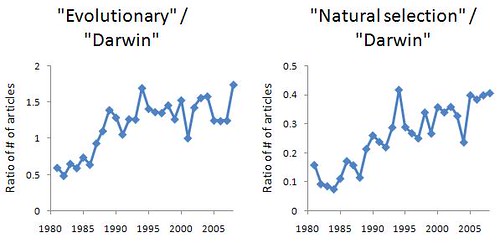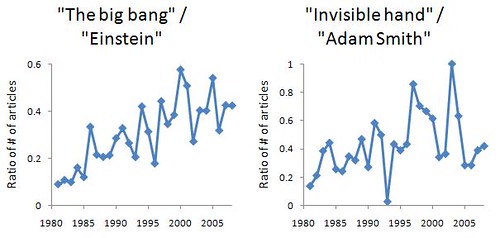|
Tuesday, May 05, 2009
Is news coverage of science focusing more on substance than before?
posted by
agnostic @ 5/05/2009 10:15:00 PM
One thing that many of us worry about is how well educated the educatable public is about biology and evolution -- are they reading superficial stories, or are they being exposed to the deeper ideas? (Set aside whether they'll remember any of it in a few years.) Actually, what most really worry about is whether or not science reporters are doing a better or worse job than before, since we can't really know how much substance the public shoud be expected to grok. There's actually a fairly crude but helpful way to measure this, so let's see what it shows.
I started with the complaint that when a science isn't very mature, people focus too much on individuals -- they're like disciples hanging on every word of the prophet, or quoting him in exegesis if he's dead. For example, Freudian, Marxism, Chomskyan, and Darwinian or Darwinism are common terms, yet they don't actually say what they're for -- just whatever the guy said. Contrast this with the rare or non-existent terms Lavoisierism, Newtonian (the far more common phrase is "classical" mechanics), etc. Adjectival forms in math are only meant to show who discovered or invented something -- Gaussian distribution, Hessian matrix, Laplace transform, etc. -- rather than refer to a large body of theory that the guy put together. This is compounded in journalism since writers usually are arts and humanities majors, who will thus be tempted to write biographical pieces and present the social history of the scientists, rather than digest what their contributions were and convey that substance to the readers. Such articles would certainly contain their names, but not necessarily the concepts they invented. So, my measure of "fluff" is the number of articles that contain a famous scientist's name (funny way of defining fluff, but you'll see). My measure of "substance" is the number of articles that mention a particular theory, concept, or whatever, associated with that scientist. I then take the ratio of substance to fluff and track this over time. This ratio answers the question: "For every article that mentioned the scientist, how many articles mentioned a big idea linked to him?" Larger values mean a greater focus on the theory itself rather than the person who invented it. I'm sure you have vivid memories from high school chemistry class about what an atom looks like, but I'll bet you find it difficult to remember what's-his-name and you-know-uh-that-guy who developed the various parts of the model. That's good -- the key ideas stuck. Now on to the data. I searched the NYT from 1981 to 2008 for "Darwin," "evolutionary," "natural selection," "Adam Smith," "invisible hand," "the big bang," and "Einstein" (removing results with "Einstein College"). And before the autistic geek brigade pipes up about how Einstein didn't propose the Big Bang -- no shit. But his ideas did help pave the way, and his name is the only one common enough to get lots of data for each year (unlike Lemaitre, who gets only 8 hits during the entire 28-year period). Likewise, general relativity and Brownian motion don't exactly get a lot of coverage. For physics, it's either the Big Bang or black holes, and the latter has been appropriated into common usage far more than the former, so using "the Big Bang" is better for making sure the context is scientific. Here are graphs showing the substance-to-fluff ratios over time:   Overall, things look good -- reporters are focusing more on the deeper ideas of the field, compared to dropping names. The year-to-year variation is a lot wilder for economics, but it's a social science, and so less mature than biology or physics. So, writers may be more fickle when they're deciding whether to focus on the ideas or to invoke some famous guy's name. Indeed, we expect that in some areas of social science, education, and health and nutrition -- which are largely presided over by a dogmatic priestly caste -- the major breakthroughs in the field won't be reported at all, or will show downward trends over time, as the ideology police slowly buries them down the memory hole. This jibes with what most people say about the NYT science reporting -- it's great for the hard sciences, but it might as well be the funny pages for social science or health and nutrition. Sure, the NYT regularly churns out stories about non-existent "trends" based on what's fashionable among a handful of neurotic Jewish mothers on the Upper West Side. But at the same time, the NYT also allows Carl Zimmer, Nicholas Wade, and John Tierney to get the word out about a lot of great research. I didn't read the NYT in 1981, as I was not even 1 year old for most of that year, but based on the above data, I would guess that the science reporting was not nearly as good as it is now. It's yet another example of how the panic about the world going to hell only applies to the arts and humanities, not the sciences. No one gives a shit about contemporary art anymore, and quoting a Yale lit crit theorist these days would only get you laughed out of the room. This is good -- people have woken up. As far as the intellectually curious crowd is concerned, though, things are only getting better. Labels: culture, New York Times, News, science |



